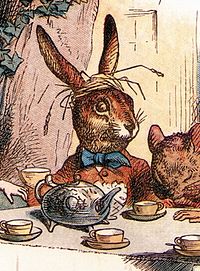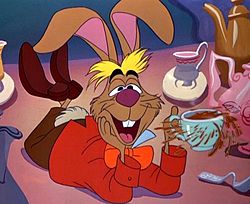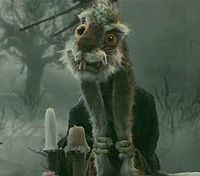- March Hare
-
This article is about the fictional character. For other uses, see March Hare (disambiguation).
March Hare Alice character 
The March Hare. Illustration by John Tenniel.First appearance Alice's Adventures in Wonderland Last appearance Through the Looking-Glass Created by Lewis Carroll Information Aliases Haigha Species Hare Gender Male Occupation Host of the Mad Tea Party
MessengerSignificant other(s) The Hatter
DormouseNationality Wonderland/Looking-Glass Land Haigha, the March Hare is a character most famous for appearing in the tea party scene in Lewis Carroll's Alice's Adventures in Wonderland.
The main character, Alice, hypothesises,
- "The March Hare will be much the most interesting, and perhaps as this is May it won't be raving mad -- at least not so mad as it was in March."[1]
"Mad as a March hare" is a common British English phrase, both now and in Carroll's time, and appears in John Heywood's collection of proverbs published in 1546. It is reported in The Annotated Alice by Martin Gardner that this proverb is based on popular belief about hares' behavior at the beginning of the long breeding season, which lasts from February to September in Britain. Early in the season, unreceptive females often use their forelegs to repel overenthusiastic males. It used to be incorrectly believed that these bouts were between males fighting for breeding supremacy.[2]
Like the character's friend, the Hatter, the March Hare feels compelled to always behave as though it is tea-time because the Hatter supposedly "murdered the time" whilst singing for the Queen of Hearts. Sir John Tenniel's illustration also shows him with straw on his head, a common way to depict madness in Victorian times.[3][4] The March Hare later appears at the trial for the Knave of Hearts, and for a final time as "Haigha" (which Carroll tells us is pronounced to rhyme with "mayor"), the personal messenger to the White King in Through the Looking-Glass.
Contents
Interpretations
Disney Animated Film
Main article: Alice in Wonderland (1951 film)March Hare 
The March Hare as he appears in the 1951 film.First appearance Alice in Wonderland (1951) Voiced by Jerry Colonna
Maurice LaMarcheInformation Species Hare Gender Male Significant other(s) Mad Hatter
DormouseNationality Wonderland Disney's Alice in Wonderland, an animated film, depicted the March Hare at the tea party as being deliriously confused. He repeatedly offers Alice a cup of tea, but distractedly pulls the cup out of her reach or takes it from her hands just as she is about to drink. He was voiced by Jerry Colonna, after whom his appearance and personality were modelled, and later by Maurice LaMarche. He was animated by Ward Kimball. This version of the character was also a semi-regular on Bonkers and one of the guests in House of Mouse, often seen seated with the Mad Hatter.
Tim Burton's Alice in Wonderland
Main article: Alice in Wonderland (2010 film)"Thackery Earwicket" redirects here. For people with similar names, see Thackery.Thackery Earwicket 
Thackery Earwicket as he appears in the 2010 film.First appearance Alice in Wonderland (2010) Created by Tim Burton Voiced by Paul Whitehouse Information Aliases March Hare Species Hare Gender Male Occupation Cook Significant other(s) Tarrant Hightopp
MallymkunNationality Underland The March Hare appears in the 2010 Disney film Alice in Wonderland, voiced by Paul Whitehouse. His full name is Thackery Earwicket; this, however, is not mentioned in the film. In the movie, the March Hare behaves as if constantly nerve-wracked and completely delirious. He is a cook in the film, and the way he eccentrically throws dishes and pots suggests he is an amalgam of both the March Hare and the cook from Lewis Carroll's original book. The March Hare has a strong Scottish accent in this movie, while his friend the Mad Hatter (played by Johnny Depp) switches into a Scottish accent as well whenever his emotions are strained. He is first seen in the "Tea Party" scene, which takes place at his "Hare House" windmill. The March Hare hosts a tea party, which he shares with Tarrant Hightopp the Mad Hatter, Mallymkun the Dormouse, and Chessur the Cheshire Cat. He appears a second time in the White Queen's kitchen, frantically cooking and throwing dishes. His third appearance is at the Frabjous Day scene, in which he stands with the other characters wielding a ladle as his weapon, nervous and somewhat ready to go to battle. Burton stated that because Whitehouse is a great comedic actor, a lot of his lines came from improvisation.[5] In the book, his fighting style is to pick up one enemy and throw him at another.
Alice in Verse
Main article: Alice in Verse: The Lost Rhymes of WonderlandThe major departure from Carroll's original here is that instead of appearing a jittery witness, the March Hare is cast as the Prosecutor. After the charge is read, the Hare addresses the court with an opening statement that more or less vindicates the accused, before turning his accusing eye upon the court itself for failing to serve tea with the evidence (the tarts).
Alice in the Country of Hearts
In this Japanese manga, Alice in the Country of Hearts, the March Hare is Elliot March. Elliot is Blood Dupre (the Hatter)'s right hand man. He is basically human with the exception of two, brown rabbit ears. When called a rabbit, he often becomes insulted and rants about how his ears are 'just bigger than average'. He isn't specifically crazy or mad, but he is a bit violent in the beginning. He almost kills Alice with his long-barrelled gun before Blood stopped him. But, as the story progresses, it is shown that Elliot is a lovable, amusing character who is really very sweet.
Pandora Hearts
In this Japanese manga, Pandora Hearts, the March Hare is a "Chain" whose "Contractor" is Reim Lunettes. It has the ability to fake death which helps Reim escape his attackers and proved to be so realistic that his comrades believed he really was dead. The March Hare was said to be a "gentle Chain" which was not suited for battle, but very useful in its own ways. In a way, it contradicts all the varieties of the March Hare, as the Hare is shown to be mad or even insane.
Cultural references
Computer/Video Games
American McGee
- In the game American McGee's Alice, the March Hare is portrayed as a victim of the Mad Hatter's insane experimentation. Both the Hare and the Dormouse have become clockwork cyborgs.
- The March Hare appears in Alice: Madness Returns. His appearance has changed drastically, he is now larger and has gears protruding out his back. He has a metal frame in his mouth keeping it open, the frame also has a monocle attached to it. He has bolts in his ears, and his whole left arm is replaced with a large blade, which resembles a Spade. His legs have been replaced with springs, as well. In one scene, a poster of the March Hare is seen in the background which resembles the Uncle Sam Wants You poster with him pointing and has the words "All Aboard for Progress" at the bottom, showing the fact that Dormouse and himself have usurped Hatter's reign over the factory. The two have dismembered the Hatter and use his limbs in their own way. The March Hare uses his legs to power the gears for his compactor section of the factory. The player, as Alice, is tasked in retrieving the limbs in order to re-assemble the Hatter and to exact revenge on Dormouse and the March Hare.
Other
- In the video game adaptation of Tim Burton's Alice in Wonderland, Thackery Earwicket is a playable character. His special ability is telekinesis, and his main form of attack is to throw dishes. He also uses his big ears and large feet as weapons. He uses his telekinesis to defeat the Bandersnatch.
- The March Hare appears in the Alice in Wonderland scene of Dragon's Lair II: Time Warp.[6]
- The phrase "Mad as a March hare" is used in the video game BioShock 2.
Television and film
- In the film Mad Max, one of the police cars used by the Main Force Patrol is named March Hare.
- In SyFy's TV Miniseries Alice, the March Hare is represented by the character Mad March. Mad March is a dead assassin re-animated by the Carpenter in to a cyborg. Because Mad March’s head was missing, the Carpenter fitted him with a giant porcelain head of a rabbit. He speaks in a Brooklyn accent and sounds kind of robotic. According to the Hatter he has "a nose for blood" and is able to track targets by scent, following Alice and Hatter into Jaberwoki land and finding Alice with ease. After being tortured by Mad March, the Mad Hatter kills Mad March by punching his robotic head.
- In Wizards of Waverly Place, during the tea party episode, it shows the March Hare.
- The March Hare that appears in Dragon's Lair II appears in the "Top 11 Nostalgia Mindfucks" episode of The Nostalgia Critic.
- The second episode of Lori Prince Live, Lori Prince interviews the March Hare and the Hatter.
- The March Hare is re-imagined in Malice in Wonderland as the character Harry Hunt.
- The "Mad as a March hare" saying is used in the film Mary Poppins.
Comics
The March Hare has been featured in many Alice in Wonderland comics. Also, in Detective Comics #841, a women named March Harriet appeared alongside the Wonderland Gang led by a mind-controlled Jervis Tetch.
References
- ^ Carroll, Lewis. Alice's Adventures in Wonderland : ?
- ^ BBC Radio 4, Dylan Winter, Shared Earth, Feb 9th 2007
- ^ Alice in Wonderland (3): Overview of chapters 7-12
- ^ Story origins - Lenny's Alice in Wonderland site
- ^ Salisbury, Mark; Burton, Tim (2010). Alice in Wonderland: A Visual Companion. Disney Editions. p. 120. ISBN 978-1-4231-2827-8.
- ^ The Nostalgia Critic: Top 11 Nostalgia Mindfucks Part 1
External links
Categories:- Alice in Wonderland
- Lewis Carroll characters
- Fictional characters introduced in 1865
- Fictional hares and rabbits
- Fictional anthropomorphic characters
- Disney's Alice in Wonderland characters
- Film characters
- Fictional cyborgs
- Fictional assassins
- Metafictional characters
Wikimedia Foundation. 2010.
